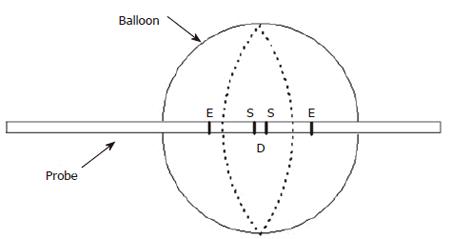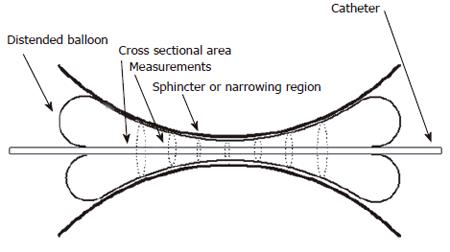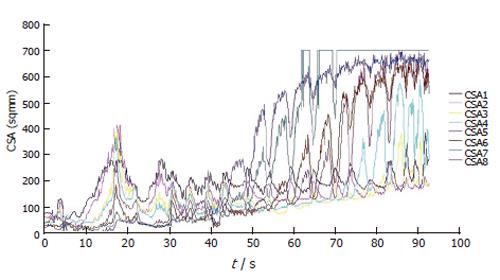Copyright
©2006 Baishideng Publishing Group Co.
World J Gastroenterol. May 14, 2006; 12(18): 2818-2824
Published online May 14, 2006. doi: 10.3748/wjg.v12.i18.2818
Published online May 14, 2006. doi: 10.3748/wjg.v12.i18.2818
Figure 1 Sketch of a conventional impedance planimetry probe with a single set of excitation (E) and sensing (S) electrodes for the measurement of cross-sectional area in the middle of the bag.
D is the distance between the sensing electrodes.
Figure 2 Diagram showing multi-electrode probe by Andersen et al for measuring 5 CSAs in the porcine rectum.
Figure 3 Plot showing the changes in the CSAs at the proximal (P), middle (M) and distal (D) electrode pairs as the balloon is distended at a constant flow rate indicated by the increase in volume.
Figure 4 An example of how a probe which can measure 8 CSAs could profile the geometry of the narrowing region of a bodily sphincter.
Figure 5 Plot showing changes in the 8 measured CSAs during bag distension at 40 mL/min.
CSA1 is the most distal and CSA8 is the most proximal.
Figure 6 Three dimensional reconstruction of the OGJ geometry in a human volunteer after distension in to a volume of 40 mL.
All dimensions are in millimeters. Colour change is indicating increased radius.
Figure 7 Geometric profile of the porcine OGJ before and after the placement of 3 sutures in the OGJ.
T indicates the point where wall tension was measured.
- Citation: McMahon BP, Drewes AM, Gregersen H. Functional oesophago-gastric junction imaging. World J Gastroenterol 2006; 12(18): 2818-2824
- URL: https://www.wjgnet.com/1007-9327/full/v12/i18/2818.htm
- DOI: https://dx.doi.org/10.3748/wjg.v12.i18.2818















